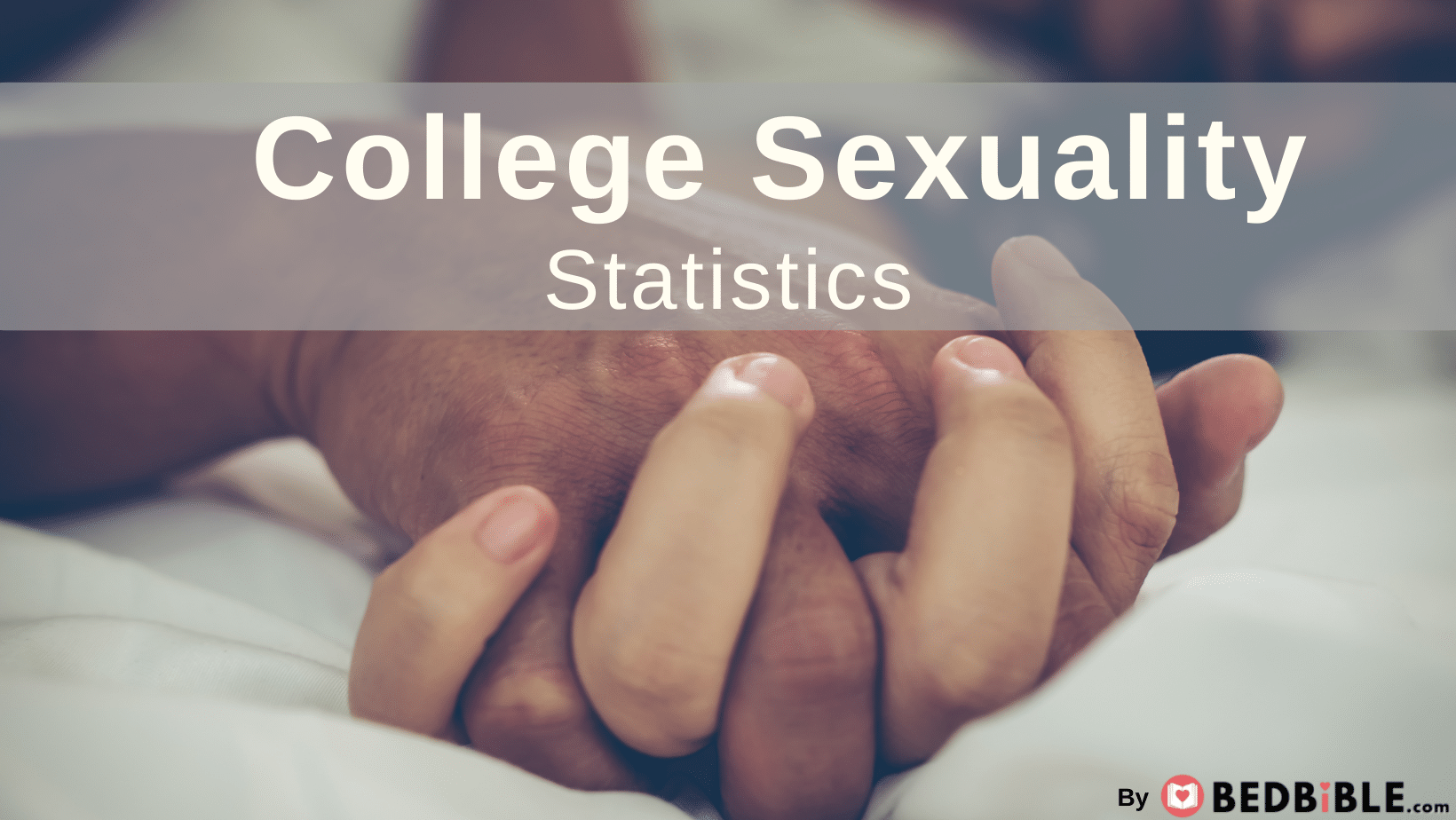
College life is often considered a transformative period, a time for academic growth and personal exploration. But what role does sexuality play in this pivotal stage? Bedbible Research Center delves into this intricate subject with a comprehensive statistical analysis that covers everything from birth control methods to the prevalence of non-consensual sexual activity on college campuses. This article presents key takeaways such as the most sexually active campuses, the average number of sexual partners students have, and the percentage of students who report experiencing sexual violence.
So why should you trust this piece? Bedbible Research Center is a reputable source that employs rigorous methodologies to gather and analyze data. Their findings offer a nuanced understanding of the sexual behaviors and concerns of college students, providing valuable insights for students, educators, and policymakers alike. Intrigued? Read on to discover the sexual landscape of college life in the U.S., backed by reliable statistics.
If you have any questions about the statistics or want the updated dataset used for these findings feel free to reach out to email: researchcenter@bedbible.com
➔ Key Takeaways
- Temple University in Philadelphia, Pennsylvania, is the most sexually active campus
- The most used birth control methods are: Birth Control Pills (49.8%) and Male condoms (45.7%)
- 40.9% of the women who obtained an adoption have a College / Associate Degree
- The top concern for a college student is; Relationship problems
- 13.7% of females in college experience non-consensual sexual activity
- 41% of women and 49% of men reported not being sexually active in college at all
- 70 percent of women and 80 percent of men reported being in love
- Only 20% of female students who experience sexual violence, age 18-24, report to law enforcement.
- 4.9 persons is the average number of sexual partners you’ll have throughout college
- 38% of college students always use condoms
Table of contents
U.S. College Students that Used Selected Methods of Birth Control
The top 5 birth control methods used by college students in the U.S. include:
- Birth control pills (49.8%)
- Male condoms (45.7%)
- Withdrawal (24.7%)
- Intrauterine device or IUD (15.3%)
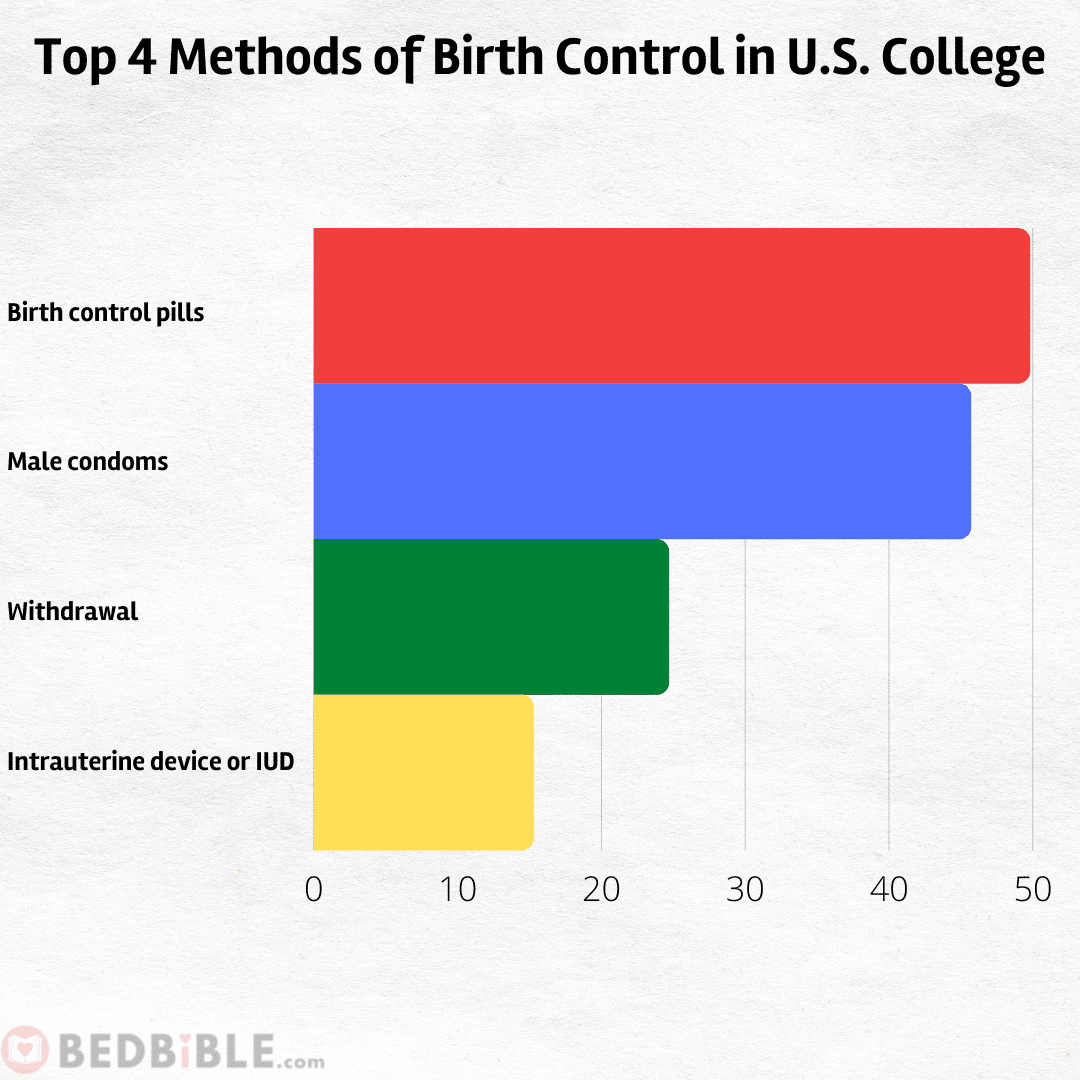
Women in the U.S. Who Obtained an Abortion (by Educational Level)
- Some College / Associate Degree (40.9%)
- High School Graduate/GED (27%)
- College Graduate (23.1%)
- Less than High School (8.9%)
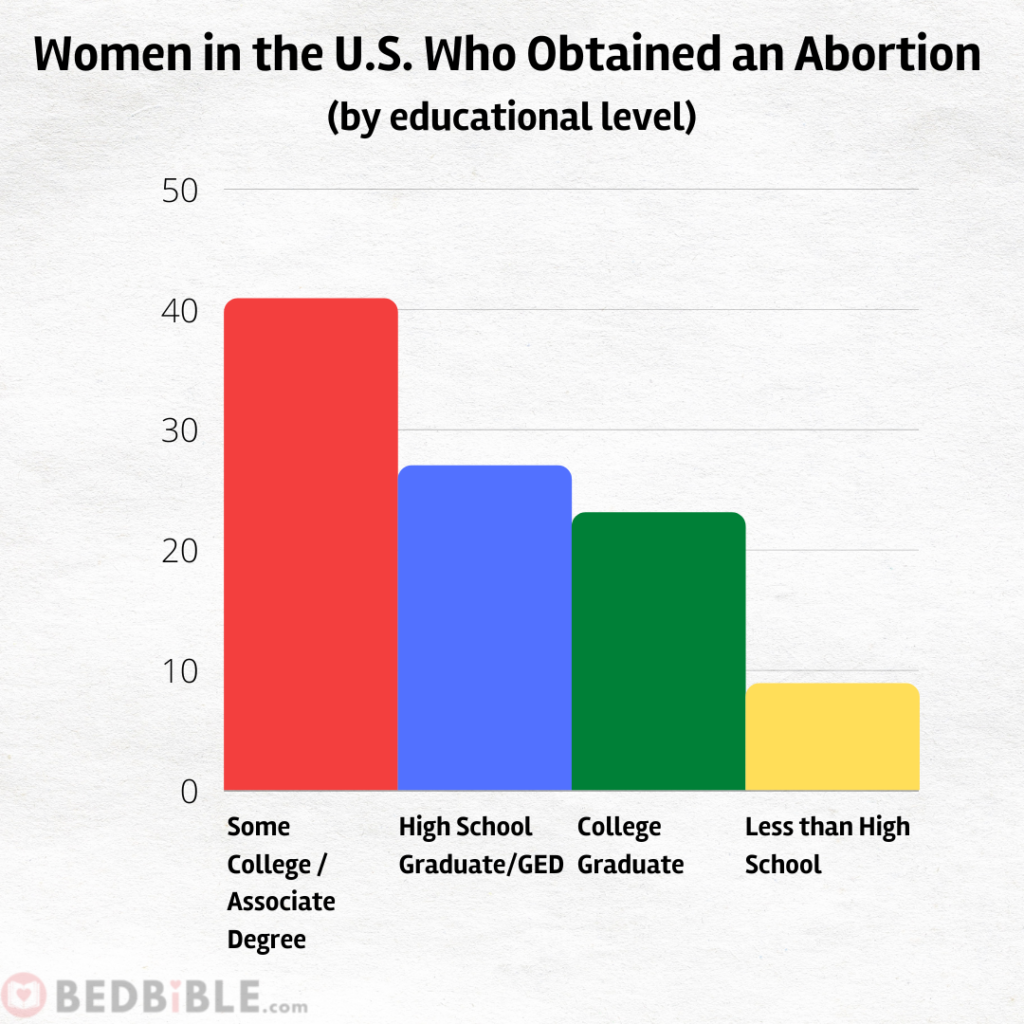
Top Concerns of College Student Patients
Sex-related issues that were concerns of college students in the U.S. include:
- Sexual abuse/assault (1.7%)
- Physical abuse/assault (0.2%)
- Sexual concern (0.2%)
- Sexual orientation (0.2%)
- Pregnancy-related (0.1%)
The most frequent concerns of college students are:
- Anxiety (24%)
- Depression (18%)
- Relationship problems (7.2%)
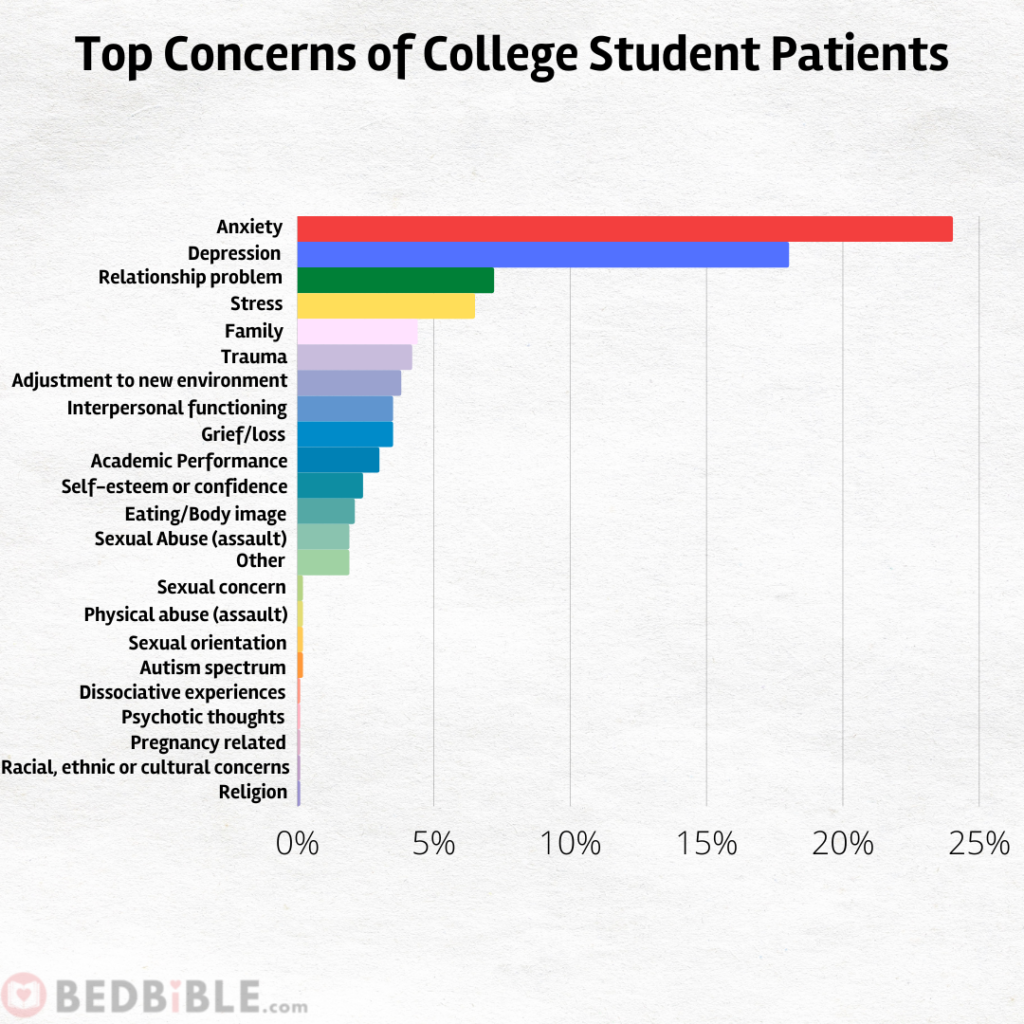
Share of Students Experiencing NonConsensual Sexual Contact Since Enrolling at University in the U.S.
From the data, it’s evident that nonconsensual sexual contact is a significant concern across all gender identities. Female students and those identifying as TGQN report higher percentages of both penetration and sexual touching without consent compared to male students. It’s crucial for institutions to be aware of these statistics and work towards creating a safer environment for all students.
| Gender/Identity | Penetration | Sexual Touching |
|---|---|---|
| Male | 3% | 5.4% |
| Female | 13.7% | 20.5% |
| (TGQN) Transgender, genderqueer, nonbinary, or otherwise gender nonconforming | 16.7% | 21.7% |
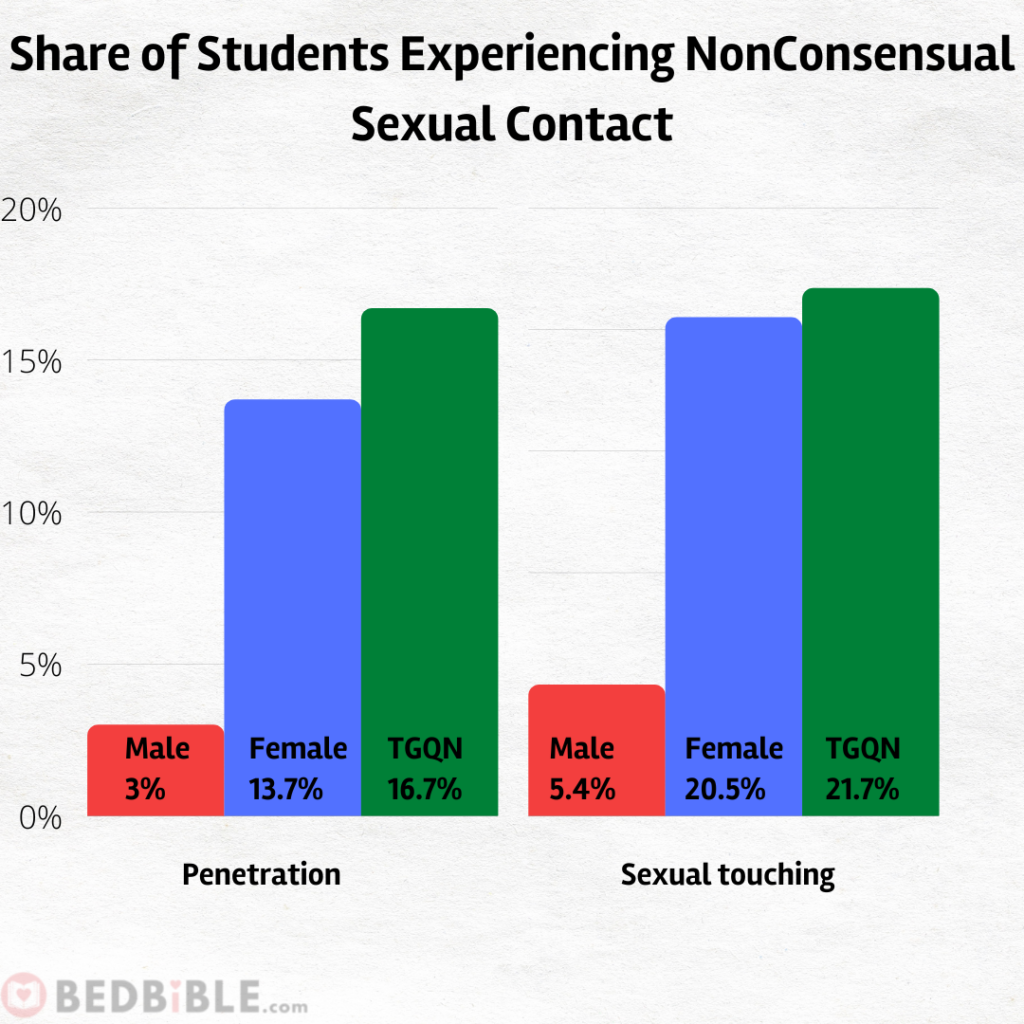
Disparities in Nonconsensual Sexual Experiences Across College Year Groups and Gender Identities
- There is a 5.6% difference between female seniors and female junior students who experienced nonconsensual sex in 2019
- 16.5% of female freshmen and 22.7% of female sophomore students
- Seniors had the highest percentage of experiencing nonconsensual sex contact (28.9%) among TGQN college students
- Junior students were 5.6% higher than sophomore students among TGQN students who experienced non-consensual sex
- 8.9% of male senior students experienced nonconsensual sex contact
- 3.8% of male freshmen students had nonconsensual sex experience in college
College Sex Habits
In 2015, a study conducted on 700 college students
- 41% of women and 49% of men reported not being sexually active at all
- 70 percent of women and 80 percent of men reported being in love
- 17 percent of women and 27 percent of men said they use dating apps
- 12 percent of women said they had been raped compared to 4 percent of men
In 2017, another study revealed the following:
- 59% of college students are “mostly” or “always” using a “barrier method” during vaginal sex
- 44.9% are “mostly” or “always” using a “barrier method” for anal sex
- 10% are “mostly” or “always” using a “barrier method for oral sex
College Campus Sexual Violence
- Male college students (aged 18-24) are 78% more likely than non-students of the same age to be a victim of rape or sexual assaults
- Female college students (aged 18-24) are 20% less likely than non-students of the same age to be a victim of rape or sexual assaults
- Only 20% of female students who experience sexual violence, age 18-24, report to law enforcement.
- Only 32% of non-student females, aged 18-24, report to law enforcement.
Most Sexually Active College Student Bodies in the U.S.
- Temple University in Philadelphia, Pennsylvania, is the most sexually active campus
- Rutgers University, in New Jersey, ranked as the second most sexually active group of students
- Other schools that made it into the top 5 include Florida State University, the University of Central Florida, and the University of Florida
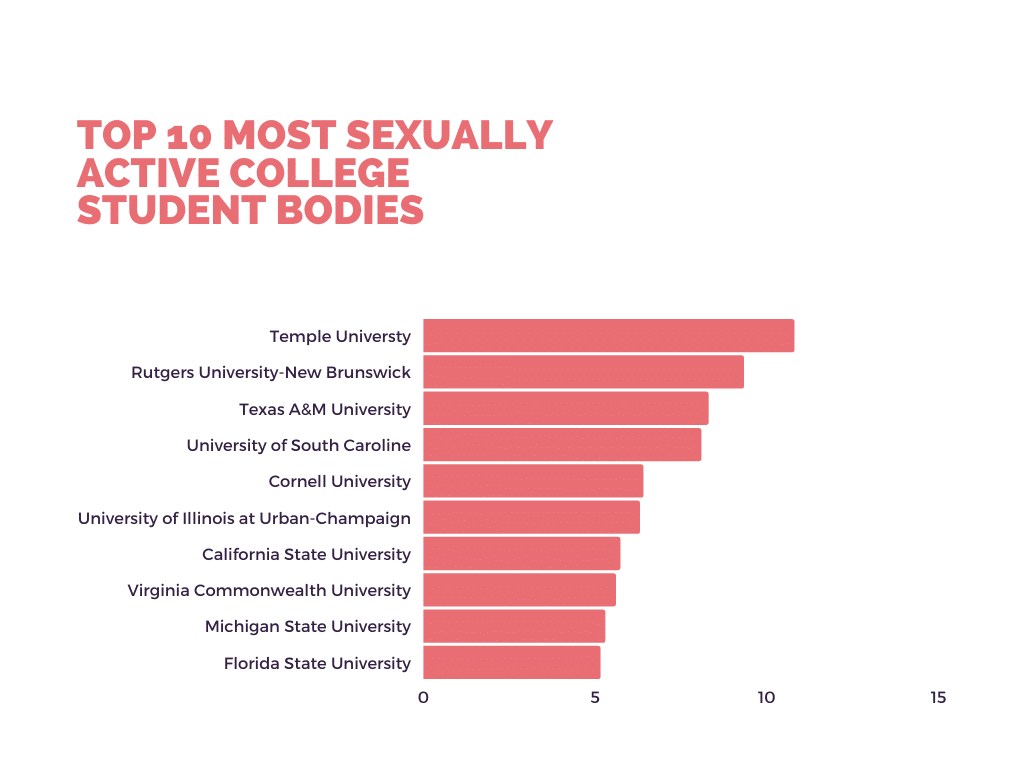
Sexual Partners Respondents Had While in College (by Gender)
Respondents: (Women=43%; Men 35%)
- Male respondents mentioned that they had an average of 14.22 sexual partners in overall sex life and 4.98 partners in college.
- Female respondents stated that they had an average of 11.41 sexual partners in overall sex life and 4.90 sexual partners in college.
How Often Do College Students Wear Protection
Number of Respondents Who Use Condoms
- Always (38%)
- Usually (24%)
- Never (15%)
- Sometimes (14%)
- Other (4%)
- Only When Their Partners Ask (4%)
- Only When It’s Available (1%)

Number of Respondents who Use Condoms (by Gender)
College students can be more exposed to sexual activities as they meet new partners and colleagues. This is why it is important to learn various statistics related to having safer and more enjoyable sexual activities while learning.
- 50% of men and 50% of women respondents revealed that they always use condoms
- 61% of women respondents and 39% of male respondents usually use condoms
- 65% of male respondents and 35% of women respondents stated that they use a condom only when it’s available
- 53% of male respondents and 47% of female respondents never use condoms

How Common is Cheating in College Relationships?
65% of college students have sex or fall in love with someone other than their partner
About 65% of college participants reported that they had had sex with someone else, fallen in love with someone else, or both while involved in a committed relationship.
About 80% of participants suspected or knew that their partner in a committed relationship had had sex with someone else, fallen in love with someone else, or both while involved with the participant.
The study was conducted across two college student groups, first a small preliminary study of 53 participants, and secondly a study of 655 college students.
64% of college students have seen someone on Tinder they knew were in a committed relationship
- 64% of college students have seen someone on Tinder they knew were in a committed relationship.
- 73% of college students have male friends on Tinder that are on a relationship.
- 98% believe that Tinder is used for cheated to some extend (12% believe it’s used for that all the time).
- 56% of college students have female friends that are on Tinder while in a relationship.
- 7.6% of college students self-report to be actively dating multiple people.
Below are the full list of results from the study.
| Infidelity questions about Tinder | N | % |
|---|---|---|
| Spent time with somebody met on Tinder | ||
| Yes | 60 | 12.5% |
| No | 421 | 87.5% |
| Messaged somebody on Tinder | ||
| Yes | 83 | 17.1% |
| No | 401 | 82.9% |
| Physically intimate with somebody met on Tinder | ||
| Yes | 43 | 8.9% |
| No | 438 | 91.1% |
| Sexual with somebody met on Tinder | ||
| Yes | 35 | 7.2% |
| No | 449 | 92.8% |
| Seen somebody on Tinder who knew was in exclusive relationship | ||
| Yes | 310 | 63.9% |
| No | 175 | 36.1% |
| Male friends used Tinder while in relationship | ||
| Yes | 354 | 73.1% |
| No | 130 | 26.9% |
| Female friends used Tinder while in relationship | ||
| Yes | 272 | 56.1% |
| No | 213 | 43.9% |
| How often people use Tinder to cheat | ||
| Never | 11 | 2.3% |
| Rarely | 42 | 8.7% |
| Sometimes | 216 | 44.6% |
| Often | 157 | 32.4% |
| All the time | 58 | 12.0% |
| Tinder effective way to meet people while in relationship | ||
| Very ineffective | 72 | 14.8% |
| Ineffective | 97 | 20.0% |
| Neither effective nor ineffective | 119 | 24.5% |
| Effective | 172 | 35.5% |
| Very effective | 25 | 5.2% |
| Current relationship status | ||
| Dating multiple people | 41 | 7.6% |
| Not in a relationship | 277 | 51.1% |
| Dating one person exclusively | 196 | 36.2% |
| Cohabitating, Engaged, or Married | 27 | 5.1% |
| All College Students | 485 | – |
49% of male college students and 31% of female college students have committed sexual infidelity
Found that 49% of male and 31% of female college students had engaged in sexual infidelity.
In other words, male college students are +58% more likely to cheat on a partner, compared to female college students.
13% of college students reported currently perpetrating infidelity
- 13% of college students reported currently perpetrating infidelity.
- 24% of college reported having found out about being a victim of infidelity.
- 21% of college had been both the victim and perpetrator of infidelity.
30% of students have previously engaged in infidelity
- Approximately 30% of college students reported having engaged in infidelity.
Having some college education is a predictor for cheating
Institute for family studies found that:
While having a college degree is not linked to a higher chance of cheating, having only some college education is a predictor for cheating.
Almost equal shares of college-educated adults and those with high school or less education have been unfaithful to their spouse (16% vs. 15%).
However, the share among adults with only some college education is as high as (18%).
1 in 4 college student singles have flirted with someone in a relationship
- One in four college singles have flirted with someone who they know is in a relationship on social apps
- 25% of college students in relationships are currently flirting with other people online.
- 10% of college students in relationships have met up with the other person they flirted with.
- 1 in 5 students are very comfortable with flirting with someone on a dating app without their partner knowing.
A survey study of 3558 North American college students. Of which 1,247 were males and 2,311 females. Of the 3,558 college students 2,142 students identified as single, while 1,418 students said they were in a committed relationship.
Reference: OneClass (2019) Is Your College Sweetheart Cheating on You?. OneClass
5.6% report to have cheated, but 43% have been cheated on
Considering the fact that a lot of infidelity cases are never revealed to the victim it is an astounding difference in this study:
Only 5.6% respondents report to have cheated on a significant other, but a fairly large number of participants (43%) have been cheated on.
This speaks volumes to the implicit biases in self-reported measures. Especially on questions where respondents are expected to be biased towards a specific answer.
100 college students participated in the online survey.
Reference (old): https://www.theonlinerocket.com/featured/2020/02/12/sex-and-love-survey-reveals-differing-sexual-experiences/
29% of college students self-report to have been unfaithful
Participants were 181 young adults (118 females, 63 males) recruited from a midsized state university in the northeastern United States.
Genotypes were grouped as 7R+ (at least one allele 7-repeats or longer) or 7R- (both alleles less than 7-repeats); the 7R+ genotype was present in 24% of the sample.
50% of 7R+ individuals reported being unfaithful compared to only 22% of 7R- individuals.
From this knowledgde base we can calculate the percentage of college students who have cheated in a committed relationship. We simply also have to account for the amount of missing data on the specific question (which was 4%).
Therefore we find that:
- 24% of the sample was genotype 7R+, and 50% of this group have cheated on a partner.
- 72% of the sample was genotype 7R-, and 22% of this group have cheated on a partner.
The collective percentage of college students that have cheated on a partner is calculated as:
Percent of college students that have cheated = ( 50 x 24 + 22 x 72 ) / ( 24 + 72 )- In summation we find that the estimated percent of college students that have cheated on a partner they were in a committed relationship with was 29%.
